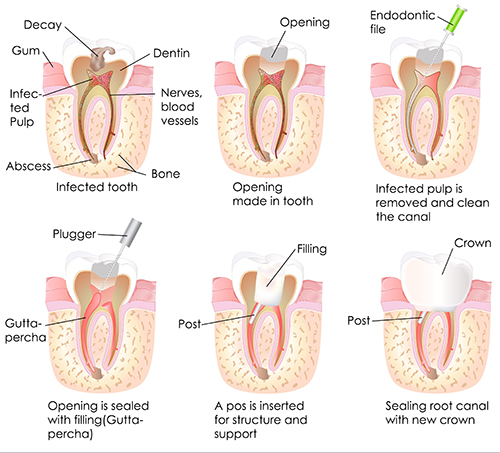ROCKY HILL dental Group
Restoring Decayed Teeth in Rocky Hill, CT
About Amalgam Fillings in Rocky Hill CT
Used by dentists for more than a century, dental amalgam is the most thoroughly researched and tested restorative material among all those in use. It is durable, easy to use, highly resistant to wear and relatively inexpensive in comparison to other materials. For those reasons, it remains a valued treatment option for dentists and their patients.
Dental amalgam is a stable alloy made by combining elemental mercury, silver, tin, copper and possibly other metallic elements. Although dental amalgam continues to be a safe, commonly used restorative material, some concern has been raised because of its mercury content. However, the mercury in amalgam combines with other metals to render it stable and safe for use in filling teeth.
While questions have arisen about the safety of dental amalgam relating to its mercury content, the major U.S. and international scientific and health bodies, including the National Institutes of Health, the U.S. Public Health Service, the Centers for Disease Control and Prevention, the Food and Drug Administration and the World Health Organization, among others have been satisfied that dental amalgam is a safe, reliable and effective restorative material.
Because amalgam fillings can withstand very high chewing loads, they are particularly useful for restoring molars in the back of the mouth where chewing load is greatest. They are also useful in areas where a cavity preparation is difficult to keep dry during the filling replacement, such as in deep fillings below the gum line. Amalgam fillings, like other filling materials, are considered biocompatible—they are well tolerated by patients with only rare occurrences of allergic response.
Disadvantages of amalgam include possible short-term sensitivity to hot or cold after the filling is placed. The silver-colored filling is not as natural looking as one that is tooth-colored, especially when the restoration is near the front of the mouth, and shows when the patient laughs or speaks. And to prepare the tooth, the dentist may need to remove more tooth structure to accommodate an amalgam filling than for other types of fillings.
About Composite Fillings in Rocky Hill CT
Composite fillings are a mixture of glass or quartz filler in a resin medium that produces a tooth-colored filling. They are sometimes referred to as composites or filled resins. Composite fillings provide good durability and resistance to fracture in small-to-mid size restorations that need to withstand moderate chewing pressure. Less tooth structure is removed when the dentist prepares the tooth, and this may result in a smaller filling than that of an amalgam. Composites can also be “bonded” or adhesively held in a cavity, often allowing the dentist to make a more conservative repair to the tooth.
The cost is moderate and depends on the size of the filling and the technique used by the dentist to place it in the prepared tooth. It generally takes longer to place a composite filling than what is required for an amalgam filling. Composite fillings require a cavity that can be kept clean and dry during filling and they are subject to stain and discoloration over time.
About Root Canal in Rocky Hill CT
 The pulp, or soft inner tissue is important during the tooth’s development. Once a tooth is fully mature, the tooth can survive without the pulp because the tooth is nourished by tissues surrounding it. The pulp is normally surrounded and protected by a layer of dentin.
The pulp, or soft inner tissue is important during the tooth’s development. Once a tooth is fully mature, the tooth can survive without the pulp because the tooth is nourished by tissues surrounding it. The pulp is normally surrounded and protected by a layer of dentin.
Above the gumline, the dentin is protected by a layer of enamel; below the gum-line the dentin is covered by cementum. When a crack or cavity destroys these protective layers, the pulp is exposed to irritants and bacteria in your mouth. This can result in inflammation then infection, and, eventually, an abscess. Periodontal (gum) disease or a severe blow to the tooth can also damage the pulp. Endodontic therapy removes the damaged pulp and usually the tooth returns to a healthy condition.
If an abscess was present before treatment the healing process may take up to 2 years.
About Dental Crowns and Caps in Rocky Hill CT
As far as dental restoration goes, crowns and caps are used synonymously.
Crowns are synthetic caps, usually made of a material like porcelain, placed on the top of a tooth.
Crowns are typically used to restore a tooth’s function and appearance following a restorative procedure such as a root canal. When decay in a tooth has become so advanced that large portions of the tooth must be removed, crowns are often used to restore the tooth.
Crowns are also used to attach bridges, cover implants, prevent a cracked tooth from becoming worse, or an existing filling is in jeopardy of becoming loose or dislocated. Crowns also serve an aesthetic use, and are applied when a discolored or stained tooth needs to be restored to its natural appearance.
Procedures
A tooth is usually reduced in size to accommodate a crown. An impression is taken and a cast is made of the existing teeth. The impression is sent to a special lab, which manufactures a custom-designed crown. In some cases, a temporary crown is applied until the permanent crown is ready. Permanent crowns are cemented in place.
Crowns are sometimes confused with veneers, but they are quite different. Veneers are typically applied only to relatively small areas.
Caring For Your Crowns
With proper care, a good quality crown could last many years. It is very important to floss in the area of the crown to avoid excess plaque or collection of debris around the restoration.
